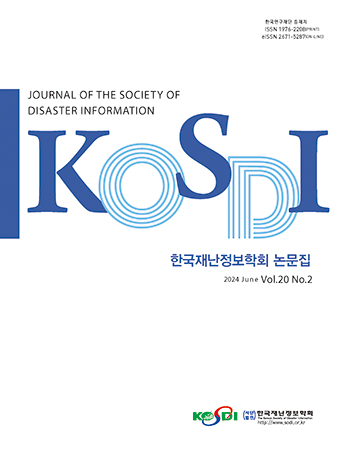Original Article
Abstract
References
Information
Purpose: In this study, the risk of flammability of a liquid mixture was experimentally confirmed because the purpose of this study was to confirm the increase or decrease of the flammability risk in a mixture of two substances (combustible+combustible) and to present the risk of the mixture. Method: Flash point test method and result processing were tested based on KS M 2010-2008, a tag sealing test method used as a flash point test method for crude oil and petroleum products. The manufacturer of the equipment used in this experiment was Japan's TANAKA. The flash point was measured with a test equipment that satisfies the test standards of KS M 2010 with equipment produced by the company, and LP gas was used as the ignition source and water as the cooling water. In addition, when measuring the flash point, the temperature of the cooling water was tested using cooling water of about 2°C. Results: First of all, in the case of flammable + combustible mixtures, there was little change in flash point if the flash point difference between the two substances was not large, and if the flash point difference between the two substances was low, the flash point tended to increase as the number of substances with high flash point increased. However, in the case of toluene and methanol, the flash point of the mixture was lower than that of the material with a lower flash point. Also, in the case of a paint thinner, it was not easy to predict the flash point of the material because it was composed of a mixture, but as a result of experimental measurement, it was measured between -24℃ and 7℃. Conclusion: The results of this study are to determine the risk of mixtures through experimental studies on flammable mixtures for the purpose of securing the effectiveness of the details of the criteria for determining dangerous goods in the existing dangerous goods safety management method and securing the reliability and reproducibility of the determination of dangerous goods Criteria have been presented, and reference data on experimental criteria for flammable liquids that are regulated in firefighting sites can be provided. In addition, if this study accumulates know-how on differences in test methods, it is expected that it can be used as a basis for research on risk assessment of dangerous goods and as a basis for research on dangerous goods determination.
연구목적: 본 연구에서는 두 물질의 혼합물(가연물+가연물)에서의 인화 위험성의 증가 또는 감소를 실험적으로 확인하고, 혼합물의 위험성을 제시하는 목적이 있기에 액체 혼합물의 인화 위험성을 실험적으로 확인하였다. 연구방법: 인화점 실험방법 및 결과처리는 원유 및 석유 제품 인화점 시험 방법으로 사용되고 있는 테그밀폐식 시험방법인 KS M 2010-2008을 기준으로 실험하였다. 본 실험에 사용한 장비의 제조사는 일본의 TANAKA사에서 생산한 장비로 KS M 2010의 시험규격을 만족하는 시험장비로 인화점을 측정하였고, 점화원으로는 LP가스를, 냉각수로는 물을 사용하였다. 또한 인화점 측정시 냉각수의 온도는 약 2℃의 냉각수를 사용하여 실험을 진행하였다. 연구결과: 실험결과로는 먼저 가연성+가연성 혼합물의 경우 두 물질의 인화점 차이가 크지 않으면 인화점의 변화가 거의 없었고, 두 물질의 인화점 차이가 낮으면 인화점이 높은 물질의 증가에 따라 인화점이 증가하는 경향을 보였으나, 톨루엔과 메탄올의 경우, 혼합물에서 인화점이 낮은 물질보다 더 낮은 인화점을 보였다. 또한 도료용 희석제의 경우, 혼합물로 이루어져서 그 물질의 인화점을 예상하기가 쉽지 않았지만 실험적으로 측정해 본 결과 -24℃~7℃사이로 측정되었다. 결론: 본 연구에서의 결과는 기존의 위험물안전관리법에서의 위험물 판정 기준에 대한 세부 내용의 실효성 확보 및 위험물 판정의 신뢰성 및 재현성 확보를 목적으로 인화성 혼합물에 대한 실험적 연구를 통해서 혼합물에 대한 위험성 판단 기준을 제시하였고, 향후 소방현장에서 단속되는 인화성 액체 대한 실험적 판정 기준에 대한 참고적인 자료를 제공할 수 있을 것이다. 또한 본 연구로 시험방법별 차이 실험에 대한 노하우를 축적한다면 위험물의 위험성 평가 연구에 있어 기초 자료이자 위험물 판정 관한 연구의 기반으로 활용될 수 있기를 기대한다.
- ASTM D 6450 (2005). Standard Test Method for Flash Point by Continuously Closed Cup (CCCFP) Tester. ASTM international.
- ASTM D 1310 (2005) Standard Test Method for Flash Point and Fire of Liquids by Tag Open-Cup Apparatus. ASTM international.
- Globally Harmonized System. (2018). Classification of Flammable Liquids. UNECE.
- Ha, D.M., Lee, S.K., Kim, M.M. (1993). "Estimation of flash point of pure flammable liquid." The Korean Society of Safety Institute, Vol. 8, No. 2, pp. 11-20.
- Koh, J.S. (2019). "Study on the risk of flammability & combustion of liquid mixtures such as alcohols." The Korean Society of Safety Institute, Vol. 15, No. 4, pp. 634-647.
- Korea Fire Industry Technology Institute (2008). Dangerous Goods Classification Guide Book. KFTI.
- Korea Ministry of Food and Drug Safety (2018). Notification. KFDA.
- Korea National Fire Agency (2018). Enforcement Decree of the Dangerous Goods Safety Management Act and the Dangerous Goods Safety Act. KNFA.
- KS M ISO 3679 (2003). Paints, varnishes, petroleum and related products - flash point test methods - rapid equilibrium method. KATS.
- KS M ISO 2592 (2007). Test Method for Flash Point and Burning Point - Cleveland Open Cup Test Method. KATS.
- KS M ISO 3680 (2008). Paint, varnish, petroleum and other related products - flash point / non-flash point test method - rapid equilibrium method. KATS.
- Lide, D.R. (1995). Handbook of Chemistry and Physics 77th edition. CRC Press.
- Occupational Safety and Health Administration (2017). Material Safety Data Sheet. OSHA.
- STM D 1120 (2007). Standard Test Method for Boiling Point of Engine Coolants. ASTM international.
- STM D 1120A (2007). Standard Test Method for Boiling Point of Engine Coolants. ASTM international.
- Publisher :The Korean Society of Disaster Information
- Publisher(Ko) :한국재난정보학회
- Journal Title :Journal of the Society of Disaster Information
- Journal Title(Ko) :한국재난정보학회논문집
- Volume : 16
- No :4
- Pages :701-711
- DOI :https://doi.org/10.15683/kosdi.2020.12.31.701




 Journal of the Society of Disaster Information
Journal of the Society of Disaster Information







